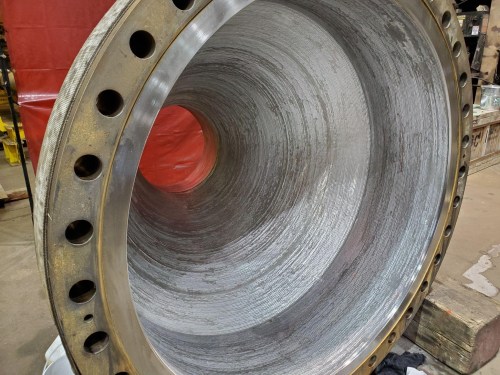
Weld Overlay & Explosion-Bonded Cladding for Heat Exchangers
Shell and tube heat exchangers are widely used in various industries for efficient heat transfer between fluids. But these exchangers often face challenges such as corrosion and wear, which can significantly impact their performance and longevity. To combat these issues, weld overlay and explosion-bonded cladding techniques can be used to enhance the corrosion and wear resistance of shell & tube heat exchangers and components.
Corrosion and Wear Resistance Applications
Weld overlay and explosion-bonded cladding are highly effective methods for providing corrosion and wear resistance to shell and tube heat exchangers. These techniques involve applying a protective layer of corrosion-resistant material, such as stainless steel or nickel alloys, on top of the base metal of the exchanger components. By adding a higher-alloy barrier between the process fluids and the base metal, the heat exchanger’s functional life can be extended without the cost of upgrading the entire metallurgy.
What is Weld Overlay?

Weld overlay is a process where a layer of higher-alloy material is applied over a base metal surface to enhance its properties, such as resistance to corrosion or wear. Weld overlay can utilize various welding techniques, including tungsten-inert-gas (TIG), metal-inert-gas (MIG), or submerged-arc-welding (SAW). This method allows for the selective enhancement of surface properties without altering the structural integrity of the entire component, providing a cost-effective solution to extend the life of the exchanger.

Two layers of weld overlay are often required to optimize both the bonding strength and the surface properties. The first layer, known as the bond layer, uses a filler metal chosen to ensure good adhesion with the base metal and toughness. This layer serves as a transition to mitigate differences in thermal expansion or metallurgical compatibility. The second layer, the wear or corrosion-resistant layer, uses a different filler metal tailored for specific surface properties like hardness or chemical resistance. This dual-layer approach effectively enhances the performance and longevity of critical components in challenging environments.
Explosion Bonded Cladding Process

Explosion bonding is a solid-state welding technique used to join two dissimilar metals. It involves placing a flyer plate over a base plate and using a controlled explosive charge to accelerate the flyer plate towards the base plate at high velocity. The impact generates a jet of molten metal that cleans surfaces of impurities, allowing the metals to bond at a molecular level. This process creates a strong metallurgical bond without the heat-related issues of conventional welding, making it ideal for combining metals with different melting points or properties.
Challenges and Applications
While weld overlay and explosion-bonded cladding offer significant benefits, they also come with certain challenges and limitations. One of the main challenges is ensuring proper adhesion between the cladding material and the base metal. If the bond is not strong enough, the protective layer may delaminate over time, exposing the base metal to corrosion. Additionally, the cladding process can introduce residual stresses in the material, which may lead to cracking or other structural issues if not properly managed.

Explosion bonding is performed on flat plate materials, and afterwards shell cylinders and heads can be formed. Weld-overlay is applied after forming, and is typically used on flanges, nozzles, and longitudinal and circumferential seams of shell and channel cylinders. Tubesheets and flat channel covers can be clad either via explosion bonding or weld-overlay processes.
What Cladding Materials Are Used?

The choice of cladding material depends on the specific corrosion and wear resistance requirements of the application. Common materials used for weld overlay and explosion bonded cladding in shell and tube heat exchangers include:
-
- Stainless steels (e.g., 304, 316, 321, etc.)
-
- Duplex steels (S31803, S32205, S32750, S32760, etc.)
-
- Nickel alloys (Inconel, Monel, Hastelloy, C276, C22, N06625, N08825, Alloy 59, C2000)
The base metal is typically carbon steel (SA-516-70N, SA-266 4N, SA-350 LF2) or low-alloy chrome-molybdenum steels (1-1/4Cr-1/2Mo, 2-¼-1Mo, etc), which provide the necessary strength at temperature and pressure for the mechanical integrity of the heat exchanger.
Examples of Services Weld Overlay and Bonded Cladding are Used
Weld overlay and explosion-bonded cladding are used in various industries where corrosion and wear resistance are critical. Some examples include:
-
- SAGD
-
- Gas processing
-
- Refining
-
- Chemical processing
-
- Power generation
-
- Desalination
-
- Pulp and paper industry
-
- Mining
Cost and Benefits Versus Other Methods

Compared to other corrosion protection methods, such as painting or coating, weld overlay and explosion-bonded cladding offer superior durability for long-term cost savings. Although the initial investment may be higher, the extended service life and reduced maintenance requirements of clad heat exchangers often justify the upfront costs. Moreover, the ability to use a less expensive base metal to meet mechanical stresses and with a higher alloy-performance cladding material for chemistry requirements can result in significant cost savings compared to using solid alloy components.
Contact Altex Industries for Services and Design for Clad Shell & Tube Heat Exchangers
Altex Industries is a leading provider of weld overlay and explosion-bonded cladding on shell & tube and air-cooled heat exchangers. With extensive experience and expertise in the field, Altex Industries has customized solutions to meet the specific needs of each application. For more information on weld overlay and explosion-bonded cladding services for shell & tube heat exchangers, please contact Altex Industries today.





